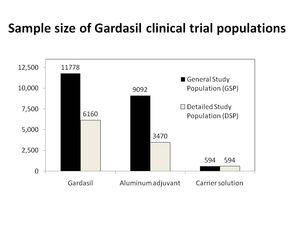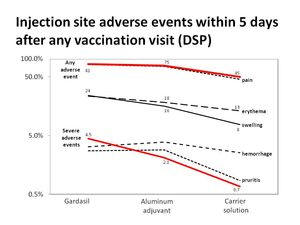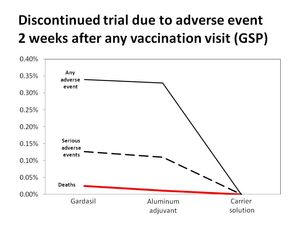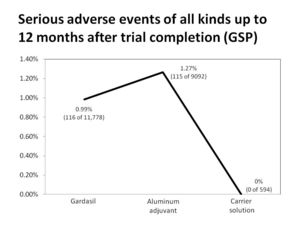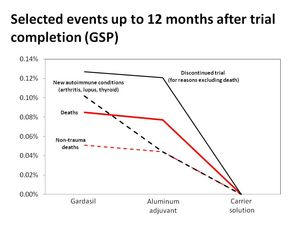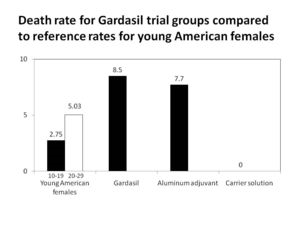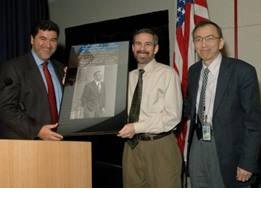 Part 1: How A
Public-Private Partnership Made the Government Merck’s Gardasil Partner
Part 1: How A
Public-Private Partnership Made the Government Merck’s Gardasil Partner
http://www.ageofautism.com
“Perhaps no
other recent product on the market demonstrates successful health care
technology transfer better than the human papillomavirus (HPV) vaccine,
Gardasil, produced by Merck & Co. and approved by the FDA in June 2006,”
proclaimed a recent National Institutes of Health (NIH) newsletter. In a
February 23, 2007 article entitled “From Lab to Market: The HPV
Vaccine”, the NIH Record celebrated the pivotal role of
government researchers in developing Merck’s Gardasil product. “Based
largely on technology developed at NIH,” the newsletter reported, “the
vaccine works to prevent four types of the sexually transmitted HPV that
together cause 70 percent of all cervical cancer and 90 percent of
genital warts (HERE).
The occasion motivating this celebratory article was the “Philip S.
Chen, Jr. Distinguished Lecture on Innovation and Technology Transfer”
given by Douglas T. Lowy, one of the NIH scientists involved in
developing the HPV vaccine. In the ceremony pictured above, Lowy is
receiving an honorary poster from the head of NIH at the time, Elias
Zerhouni, who took advantage of the occasion to shower praise on his
team’s work, one he viewed as a model for future efforts. “It’s a
‘heroic’ story about the effort to fight cervical cancer, the second
most deadly cancer for women worldwide, said NIH director Dr. Elias
Zerhouni,” in the NIH Record’s account. “He noted that he has talked
about the vaccine’s creation to Congress and with the President on his
recent visit to NIH. How researchers took the technology ‘from the lab
to the marketplace is a journey we can learn from,’ Zerhouni said.”
While Zerhouni was bragging to anyone in Washington D.C. who would
listen about the NIH team’s role in this historic accomplishment, the
vaccine's developers were actively spreading the news of their
achievement in scientific circles. It’s hard to blame them, because at
the time Lowy and his colleague John T. Schiller, leaders of the team
that had invented the technology for the “virus-like particles” (or VLPs)
that made Gardasil possible, were in some pretty heady company. In 2008,
Harald zur Hausen, the scientist who discovered the role of human
papillomavirus (HPV) in cervical cancer during the 1980s, received one
half of the Nobel Prize in Medicine; the two researchers at the Pasteur
Institute who had discovered the human immunodeficiency virus (HIV) had
to share the other half.
Perhaps campaigning for their own place in the pantheon of medical
heroes, Lowy and Schiller described their VLP technology in several
review articles on the history and development of the Merck vaccine.
These treatments were studiously scientific in tone and at points openly
critical of their commercial partner, as the authors commented with
disapproval on the high price Merck was charging for Gardasil. But in
one May 2006 review in The Journal of Clinical Investigation,
the pair also made the following disclosure about their own commercial
interests:
“Conflict of interest: The authors, as employees of the National
Cancer Institute, NIH, are inventors of the HPV VLP vaccine technology
described in this Review. The technology has been licensed by the NIH to
the 2 companies, Merck and GlaxoSmithKline, that are developing the
commercial HPV vaccines described herein.”
Attached to an otherwise heroic narrative of the triumph of technology
over cancer, this disclosure struck a discordant note. Conflict of
interest? Inventors? Vaccine technology? Licenses? Pharmaceutical
companies? Commercial vaccines? This isn’t scientific language, but
rather the language of money and commerce. What was this unusual
concession doing there in the fine print?
This is not an idle question, for Lowy and Schiller’s conflict disclosure forms the basis for an alternative to Zerhouni’s narrative, one that spotlights the unusually self-contained set of Department of Health and Human Services (DHHS) activities that surrounded HPV vaccine development. This alternative narrative is more of a business story than a scientific one, a narrative in which commercial interests were inextricably linked to matters of life and death. In this narrative, Gardasil is perhaps the leading example of a new form of unconstrained government self-dealing, in arrangements whereby DHHS can transfer technology to pharmaceutical partners, simultaneously both approve and protect their partners’ technology licenses while also taking a cut of the profits. Literally and figuratively, DHHS has the authority in such situations to allow its business partners to get away with murder for the greater good, effectively granting its private business partners a license to kill.
DHHS officials have their own language for such arrangements. They call them public-private partnerships, and DHHS agencies have gotten progressively more aggressive about pursuing them. NIH, for example, launched its own “Program on Public-Private Partnerships” in 2005, shortly before Gardasil’s launch. On the web-site describing this program, the NIH program managers concede that the kind of technology transfer involved with Gardasil carries unavoidable ethical risks, acknowledging that “The potential for conflict of interest exists any time the NIH and NIH staff engage with non-Federal entities to achieve mutual goals.” They provide little more than a pro forma solution for such conflicts, however: any concerned NIH staffers are encouraged to “contact their Deputy Ethics Counselor.”
It’s important to shed light on this alternative narrative as a counterpoint to the heroic story promoted by Gardasil’s many sponsors. An uninformed observer might like to assume that the responsible agencies of DHHS care not at all about commercial opportunities and exclusively attend in a disinterested fashion to the issues of health and safety that would naturally concern any consumer of vaccine products.
But that assumption would be incorrect. By taking a commercial perspective on Gardasil’s development and regulation, one is forced to confront a new and disturbing question. How is disinterested vaccine safety governance even remotely possible when DHHS employees stand as heroes at the head of the parade when a new vaccine is invented within its walls, while agency leaders are leading the cheering section, approving the new product’s launch, making the market for the product with its recommendations and then turning around to cash multi-million dollar checks? In order to better understand the real lessons of Gardasil under the harsh light of the business interests at work, let’s take a closer look at how the Merck-NIH partnership on Gardasil was forged.
Conflicts of interest in vaccine development and regulation
As the world’s largest single sponsor of biological research, NIH frequently funds research with commercially valuable outcomes. When that R&D generates potentially valuable inventions, NIH submits patent applications to the U.S. Patent and Trademark Office (USPTO) and actively pursues the approval of those patents, which when granted become valuable commercial property for DHHS, the patents’ owner. Since NIH has neither the authority nor the capability to pursue product commercialization efforts, in order to encourage private companies to invest in conducting the necessary clinical trials, NIH’s Office of Technology Transfer (OTT) was created to grant commercial licenses for such DHHS patents to commercial partners, including vaccine manufacturers. When new products invented at NIH clear the requisite regulatory hurdles at the Food and Drug Administration (FDA) and reach the market, OTT then shares in the profits. They also distribute the rewards back to the scientific teams whose products have succeeded in reaching the commercial stage: when license fees flow into OTT’s coffers, the Federal employees who invented the technology are entitled by NIH policy to a share of the royalties.
From a technology development standpoint, such commercial arrangements are the result of an intentional public policy; in fact they resulted from an Act of Congress. The Bayh-Dole Act of 1980 was written with the express purpose of making it easier for federally-funded academic research to receive patent protection that would allow the ready licensing of the fruits of commercially valuable R&D to private businesses. At the time, the concern of Congress was that federally funded inventions too often languished within the academy because businesses had insufficient incentive to invest in clinical trials, since these inventions were often unsupported by the powerful competitive protection afforded by an exclusive patent license.
The policy worked. Within the research universities that receive the vast majority of federal funding, Bayh-Dole has had the desired effect and has enabled university technology transfer offices all over the world to generate billions of dollars of licensing revenue in the last few decades--especially in the life sciences--by licensing patents from federally-funded university research to corporate partners. Bayh-Dole has effectively turned research into big business for many universities and transformed technology transfer offices into important profit centers at academic institutions all over the world.
But when technology licensing takes place within federal agencies, Bayh-Dole creates an entirely different problem: an unprecedented web of conflict, one in which the same departments that are tasked with regulating the health and safety of medical products are also profiting from them. As Lowy and Schiller conceded in their review article disclosure, this conflict of interest came into play directly on Gardasil: both men are named inventors on the technology that makes Gardasil possible; NIH filed for and received patents on their invention of the VLP technology; DHHS is the owner of the patent family that protects the commercial rights to the invention; in order to bring the product to market, OTT licensed the vaccine technology to Merck; and as Merck has generated billions in Gardasil revenue, OTT has received millions in Gardasil profits.
But DHHS is also responsible for regulating Gardasil in numerous ways. The FDA reviewed the clinical trials in which Gardasil was tested in human populations and passed judgment on Gardasil’s safety. An Advisory Committee on Immunization Practices (ACIP) of the Centers for Disease Control and Prevention (CDC) decided whether or not to recommend Gardasil for young women and children. The FDA and CDC together now conduct the surveillance to decide whether or not Gardasil is proving safe in larger populations. And as some families are now beginning to seek compensation based on claims that Gardasil caused injury in some of its recipients, the division of the Health Resources and Services Administration (HRSA) that oversees the Vaccine Injury Compensation Program (VICP) will soon sit in judgment as to whether, to whom, and how much compensation will be provided to Gardasil’s victims.
As you can see in the chart below, all of this activity is supervised in a single department by one Cabinet official, the Secretary of Health and Human Services. The sole non-governmental agency involved in this commercial enterprise is Merck’s Vaccine Division. In effect, the Merck-DHHS partnership leaves the business side to Merck while DHHS is solely responsible for
- Creating the market for Gardasil by funding commercial research, supervising the conduct of clinical trials, judging the outcome of those trials and promoting a policy of universal vaccination;
- Collecting the license fees that result from Gardasil revenues from Merck and other vaccine manufacturers and then distributing these financial benefits to Federal employees; and
- Deciding whether or not to protect the policy decisions and profit streams of their sister DHHS agencies through postlicensure safety monitoring and vaccine injury compensation rulings.
Is this good government at work or an example of the medical-industrial
complex run amok? In this investigative series, Age of Autism will take
a look at how DHHS agencies have managed Gardasil in all three of these
sequences. We’ll start by taking a closer look at the NIH patent
portfolio and the associated license fees that have been flowing into
NIH coffers since 2006. (Click chart to see original slide.)
Celebrating the invention of a new market
Lowy and Schiller are both employed by the National Cancer Institute
(NCI). One of the largest of the NIH institutes, NCI was established in
1937 by Franklin Delano Roosevelt. For many decades, NCI has been the
agency at the forefront of the so-called “War on Cancer.” Perhaps the
earliest inspiration for the both the Cancer War and the Gardasil
program began during the 1960s, when NCI researchers first began looking
in earnest at viruses as a potential cause for cancer. In 1961, NCI
leaders created the Laboratory of Viral Oncology to begin the search for
cancer-causing viruses; in 1962 the Human Cancer Virus Task Force was
first convened; and by the end of the decade, enthusiasm over this
research was part of the scientific momentum that persuaded President
Richard Nixon to launch the War on Cancer in 1971. Unfortunately for
Nixon’s legacy, and for most subsequent cancer victims, the War on
Cancer has famously failed to find a cure for cancer or to validate
theories of viral causation in the vast majority of human cancers.
But starting in the 1980s, the two exceptions to this litany of
failure—hepatitis B virus and the human papillomavirus--led to the
launch of two blockbuster new vaccine products. The infant hepatitis B
vaccine was developed in the 1980s and launched in 1991 with an ACIP
recommendation that all American infants be vaccinated on the first day
of life. And after 1984, when Harald zur Hausen first pinpointed the
role of certain strains of human papillomavirus in cervical cancer, the
work on another anti-cancer vaccine could begin. By the early 1990s,
laboratories all over the world were racing to develop the first HPV
vaccine.
Lowy and Schiller’s NCI team were among the four most active research
teams in this race, all of whom were aggressively filing patents on
their HPV inventions. Along with a third NCI colleague, Reinhard
Kirnbauer, Lowy and Schiller filed their first application for a patent
entitled “Self-assembling recombinant papillomavirus capsid proteins” on
September 3, 1992. Since then--and after splitting the original
application into 29 “children” in the form of numerous “divisionals”,
“continuations” and “continuations-in-part”--nine patents from that
family have been granted, as well as four from a branch of the family
tree entitled “chimeric papillomavirus-like particles.” The ability of
the novel “L1 proteins” described in their patent to “self-assemble”
into virus-like structures, which when deployed in a vaccine solution
could stimulate a protective immune response against HPV, formed the
essence of their invention. Although OTT doesn’t specify the
royalty-bearing patents, the commercially valuable technology that Merck
has licensed likely comes from this group of nine “self-assembling
recombinant papillomavirus capsid proteins” patents: US5437951,
US5709996, US5716620, US5744142, US5756284, US5871998, US5985610,
US7220419, and US7361356.
The NCI team was among the leaders in HPV technology, but the race to
make a commercially viable HPV vaccine involved several other research
teams from all over the world. Most notable among these were the
University of Queensland in Australia, Georgetown University and the
University of Rochester. In addition to NCI’s filings, each of these
university-based research teams filed their own patents; eventually,
Merck and GSK got into the act as well. Like many promising areas of
technology, the HPV patent landscape became large and crowded in a short
period of time.
Amid this blizzard of activity, the USPTO’s Bureau of Patent Appeals and
Interferences (BPAI) had to step in to sort out whether these competing
patent applications interfered with each other and to distribute the
credit, making a series of hotly contested decisions that were
ultimately appealed to the Court of Appeals for the Federal Circuit (CAFC),
the nation’s most powerful patent court. By 2007, all the BPAI and CAFC
rulings had come in and the respective contributions of all four groups
were conclusively allocated for commercial purposes. The team led by Ian
Frazer at the University of Queensland received credit for the being the
first to propose the idea of using VLP technology for a vaccine, since
their application was filed on July 20, 1992, just six weeks earlier
than the NCI team’s. But thanks to their unique technology of
“self-assembly,” most of the invention claims of the NCI patent family
remained intact as well; Lowy and Schiller’s invention has since been
generally accepted as a critical advance in the wave of new technology
that made Gardasil possible. In terms of the distribution of financial
reward, both Rochester and Queensland have reported receiving royalty
income for their HPV inventions (in undisclosed amounts) in addition to
the revenues reported by OTT.
As the technology transfer officials at OTT were paving the way for the
financial benefits from Gardasil to flow back to NIH, Lowy and Schiller
were benefiting in other ways as well, especially when it came to
scientific credit. Throughout much of 2006 and 2007, they received
awards from many quarters for their role in developing Gardasil’s
“virus-like particles.” Their joint awards included the Dorothy P.
Landon-AACR Prize for Translational Cancer Research in April 2007
and the 2007 Novartis Prize for Clinical Immunology. In
addition, Lowy by himself received the Daniel Nathans Memorial Award
in September 2007 and the American Cancer Society’s Medal of Honor
for Basic Research in October 2007.
In addition to these awards, on September 19, 2007, Lowy and Schiller
received what was perhaps their crowning honor. That’s when the
Partnership for Public Service awarded the pair the “Federal
Employees of the Year Service to America Medal.” According to its
sponsors, “The Service to America Medals have earned a
reputation as one of the most prestigious awards dedicated to
celebrating America’s civil servants. Often referred to as the 'Oscars'
of government service," they are more commonly known in government
circles as the “Sammies.” Upon receiving his crowning honor, Lowy was
interviewed for the NIH Record and professed the requisite
modesty in its October 2007 edition, saying “We are simply symbols of
the many people who have made critical contributions to understanding
the relationship between papillomavirus infection and cervical cancer.”
If Lowy was modest, the top brass at NIH could barely conceal their
pride over their employees’ accomplishments. According to the
Partnership for Public Service, “Lowy and Schiller’s 20-year partnership
has been a boon to the nation’s health and for the advancement of
scientific discovery.”
Collecting the licensing fees
Alongside the science and policy celebrations, the business
side of the Merck-NIH partnership proceeded with a bit less fanfare and
with a different kind of currency. Once their patent was approved, OTT
could then turn to extracting their share of the benefits from their
commercial partners’ new products, which in the case of HPV vaccine
included sales first from Merck’s Gardasil product and later from
GlaxoSmithKline’s Cervarix. Merck reached the market first in 2006, but
GSK followed shortly thereafter in 2007. As each company began
collecting revenue from their new vaccines, OTT began collecting
royalties. The table below shows Age of Autism’s analysis of how Merck
and GSK’s revenues may have flowed into OTT’s coffers.
|
|
Gardasil Revenue ($M) |
Cervarix revenue ($M) |
NIH Top 20 Revenues ($M) |
HPV Rank in NIH Top 20 |
HPV Revenue: estimated at 1% license fee ($M) |
|
2006 |
235 |
-- |
NA |
NR |
|
|
2007 |
1,481 |
20 |
71 (est) |
#4 |
15 |
|
2008 |
1,403 |
229 |
77.4 |
#2 |
16 |
|
2009 |
1,108 |
292 |
75.7 |
#1 |
14 |
Both Merck and GSK itemize revenue for Gardasil and Cervarix in their quarterly and annual earnings statements. Their annual results are summarized in the first two columns of the table. For Merck, Gardasil has been a blockbuster success, yielding a cumulative total of over $4 billion in revenue through year end 2009. By contrast, GSK’s revenues have been growing more slowly and have not yet reached a cumulative total of half a billion dollars.
For their part, OTT does not itemize their HPV license revenues. However, they do report their total royalty revenue as well as the cumulative revenue from their “top 20” technology licenses since 2007. These top 20 licenses have been worth over $70 million annually in profits for NIH in the last three years, and HPV licenses have soared to the top of those rankings quickly. Last year, OTT reported that HPV licensing was its top revenue generator. OTT doesn’t disclose exactly how much the Gardasil and Cervarix royalties contribute to NIH, but if we make the assumption that their patent licenses entitle them to 1% of the HPV vaccine revenues of their partners (an assumption that appears reasonable based on the available data), then we can safely estimate that OTT has been collecting somewhere in the range of $15 million per year from Lowy and Schiller’s invention.
In addition to their numerous scientific awards for their discoveries, Lowy and Schiller have received cash distributions from NIH based on their patents. As Federal employees, they are each eligible to receive a share of patent royalties up to $150,000 per year and Gardasil’s success has guaranteed that they would receive the maximum reward. That means that since FDA’s approval in 2006, each man has earned roughly a half million dollars in royalty revenue.
* * *
This is the DHHS vision of public private partnership at work. Contrary to the rhetoric, these partnerships aren’t simply a high-minded collaboration of scientific visionaries, but rather a large commercial enterprise with extraordinary profits at stake: an enterprise from which NIH receives credit and money and based on which its corporate partners build multi-billion dollar businesses.
How does such a partnership affect the incentives of regulators whose job it is to make sure the products are safe? It’s not obvious that they do. Just because DHHS has a financial stake in Gardasil doesn’t necessarily mean that every subsequent decision its employees make is corrupt, part of some nefarious conspiracy to kill young women for money. Indeed, HPV royalty revenues of $15 million represent just a small fraction of a DHHS budget that rose to well over $700 billion in 2009. In the larger scheme of things, DHHS revenues on Gardasil are just a small drop in a very large bucket.
Far more likely to play a role, however, in public-private paternerships like the Gardasil vaccine are the insidious cultural pressures that emerge in a supremely political organization like DHHS. Can we really expect the Secretary of HHS to take his or her FDA Director to task for implementing lax standards on vaccine approval when the Director of NIH is simultaneously praising the “heroic” researchers who invented the product in the first place? Is it more likely that CDC will apply extra caution in their vaccine policy recommendations when its sister agency is involved or will they be more likely to activate the fast track in their process of making recommendations for Gardasil? What we have observed so far merely suggests the potential for bias in the regulation of products in which DHHS holds a direct stake. In the next part of our series, Age of Autism will investigate the question of whether or not there have been actual patterns of bias in the ways in which regulators at FDA and CDC have conducted their duties with respect to Gardasil.
--
